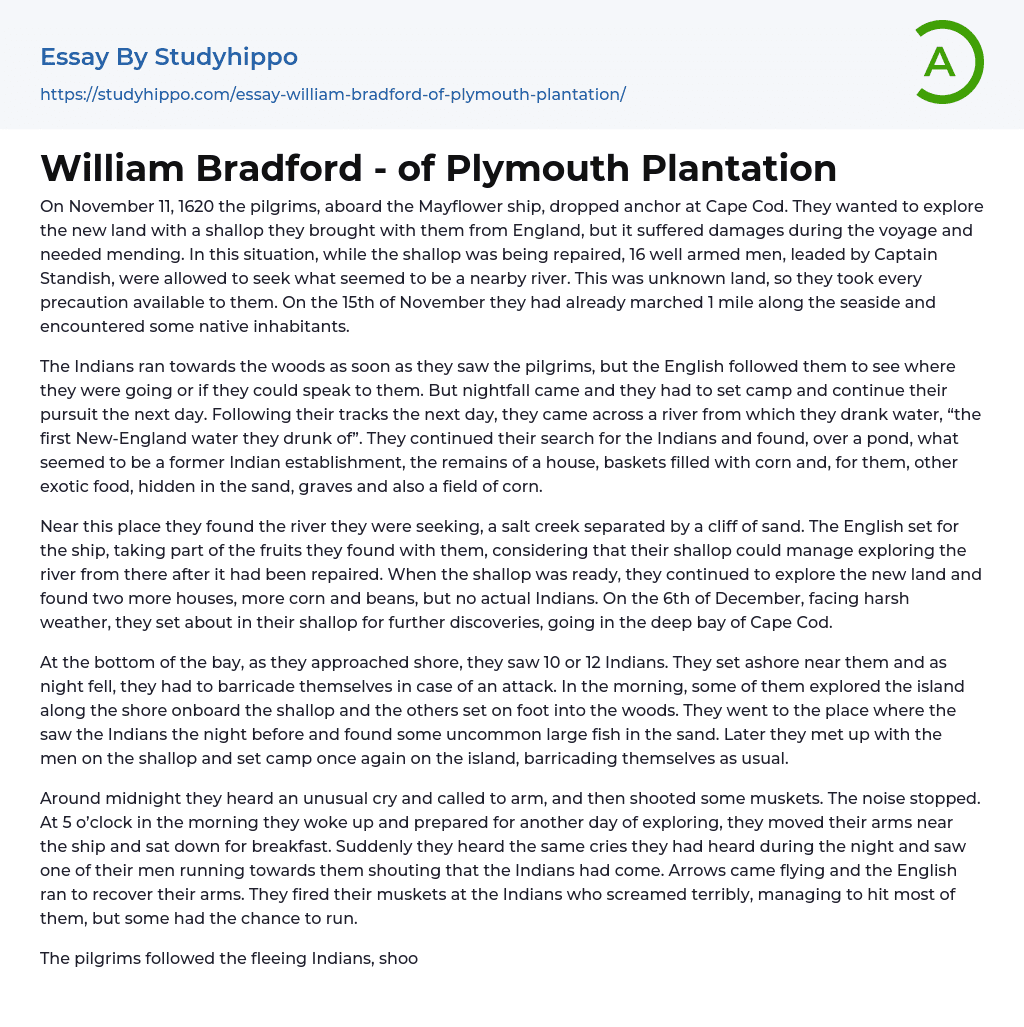The Mayflower, carrying pilgrims, anchored at Cape Cod on November 11, 1620. The newcomers had a shallop aboard their ship for exploring the newfound territory, but it suffered damage during the journey and required repair. While the shallop was under repair, Captain Standish led a group of 16 heavily armed men to navigate towards what seemed to be a closeby river. As the land was unfamiliar, they took utmost precautions. By November 15th, they had already trekked a mile along the coast and stumbled upon some local residents.
Upon sighting the pilgrims, the Native Americans promptly retreated into the forest. The English decided to trail them, hoping either to discern their destination or establish communication. However, as night fell, they were compelled to set up camp and resume their chase in the morning. The succeeding day, tracing t
...heir footsteps led them to a river from which they drank, marking their initial consumption of New-England water. They pressed on with their quest for the natives and discovered a site by a pond that gave indications of being a prior Indigenous settlement. They found remnants of a dwelling, corn-filled baskets and other unfamiliar food buried in the sand, tombs, and also a cornfield.
In close proximity to their location, the river they were in search of was discovered. It was a salt creek divided by a sandy cliff. The English proceeded to establish their ship, bringing along a portion of the fruitage they stumbled upon, with the assumption that their shallop was capable of further exploration of the river after undergoing the necessary repairs. Upon getting the shallop operational again, they continued their quest of the undiscovered land wher
they found two additional houses, an abundance of corn and beans, but not a single trace of Indians. As they dealt with harsh weather conditions on December 6th, they navigated their shallop into the deep bay in Cape Cod for more discoveries.
When nearing the shore at the bottom of the bay, they sighted around 10 to 12 Native Americans. They made landfall near this group and proceeded to establish a barricade as night came to guard against potential attacks. When day broke, some embarked on an exploration of the island's coastline using a shallop, while others journeyed on foot into the forested areas. The latter group arrived at the previous night's location of the Native Americans and discovered unusually large fishes in the sand. Eventually, they reunited with their companions on the shallop and made another campsite on the island, surrounding it with their customary barricade.
Close to midnight, they detected an unusual scream, which led them to arm themselves and fire their muskets. The noise then ceased. They roused at 5 am, ready for another day of adventure. Their arms were moved closer to the ship as they settled for breakfast. Abruptly, the same cries heard during the night filled the air again, and they saw one of their crew members sprinting towards them, yelling that the Indians had arrived. Arrows whizzed past them as the English dashed to regain their weapons. They responded by shooting their muskets at the Indians who yelled horrifically. They hit a majority of them, although a few managed to escape.
The voyagers pursued the retreating Native Americans, firing their firearms and indicating that they harbored no fear. In the aftermath
of what would later be referred to as the First Encounter, no harm came to any Englishman. They left this region of the land via the Mayflower, embarking on a quest for another port, one recommended by Mr. Coppin, who had prior experience with it. The weather took a turn for the worst, with rain and snow setting in, and by mid-afternoon, a storm had erupted which damaged their rudder and mast, thereby necessitating that they dock near an unfamiliar harbor.
As dusk fell, they chanced upon an island and decided to set up camp, only realizing that it was indeed an island upon daybreak. Assured they were safe from the native Indians, they gave thanks to God and prepped for the Sabbath. When Monday arrived, they surveyed the harbor, ascertaining its suitability for sailing before heading back to the Mayflower. Once there, they relayed the good news of having discovered a suitable anchoring location. On December 15th, they began their journey towards the newly identified harbor, but unfavorable weather conditions meant that they couldn't anchor until December 16th. Finally, construction of the first communal house commenced on December 25th.
- Russian Empire essays
- Ancient Greece essays
- British Empire essays
- Historical Figures essays
- Nazi Germany essays
- Roman Empire essays
- War essays
- Revolution essays
- 19Th Century essays
- Historiography essays
- History of the United States essays
- 20Th Century essays
- World History essays
- Vikings essays
- Declaration of Independence essays
- Civilization essays
- Evidence essays
- Genocide essays
- Colonialism essays
- Rebellion essays
- 1960S essays
- 1920S essays
- 1950S essays
- Letter from Birmingham Jail essays
- Louisiana Purchase essays
- The Columbian Exchange essays
- World Hunger essays
- What is History essays
- Bravery essays
- Gilded Age essays
- Vladimir Lenin essays
- Alexander The Great essays
- Sparta essays
- Victorian Era essays
- Henry v essays
- Stonehenge essays
- Frederick Douglass essays
- Mahatma Gandhi essays
- Joseph Stalin essays
- Geert Hofstede essays
- George Eliot essays
- Ginevra King essays
- John Keats essays
- Siegfried Sassoon essays
- Ben jonson essays
- Billy elliot essays
- Wilkie collins essays
- John Proctor essays
- Harriet Tubman essays
- Napoleon essays




